
Star Trek: Insurrection is a 1998 American science fiction film directed by Jonathan Frakes. It is the ninth film in the Star Trek film series, as well as the third to star the cast of Star Trek: The Next Generation, with F. Murray Abraham, Donna Murphy, and Anthony Zerbe appearing in main roles. In the film, the crew of the USS Enterprise-E rebels against Starfleet after they discover a conspiracy with a species known as the Son'a to steal the peaceful Ba'ku's planet for its rejuvenating properties.

Star Trek: Armada is a real-time strategy video game for Microsoft Windows developed and published in 2000 by Activision. The game's look and feel is based primarily on Star Trek: The Next Generation, and features a few of its main characters and ships. Playable factions include the United Federation of Planets, the Klingon Empire, the Romulan Star Empire and the Borg. The game received mixed to positive reviews and was noted for being one of the better Star Trek games to be made. A sequel, Star Trek: Armada II, was released on November 16, 2001.
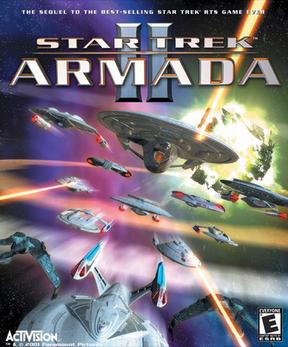
Star Trek: Armada II is a real-time strategy video game published by Activision in 2001, based upon the Star Trek universe. The game was developed by Mad Doc Software. It is the sequel to Star Trek: Armada. Star Trek: Armada II was released by Activision a year after they acquired the full rights to all the franchise holding of the video game's franchise from Viacom. It was the first of the three major Star Trek video game sequel titles that were released by Activision from 2001 until their departure from the franchise in 2003. On December 13, 2021, both Armada and Armada II were re-released on GoG.com, which had also released several other older Star Trek titles earlier that year.
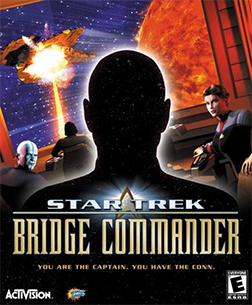
Star Trek: Bridge Commander is a space combat simulation video game for Microsoft Windows, developed by Totally Games and published by Activision in 2002, based in the Star Trek universe.
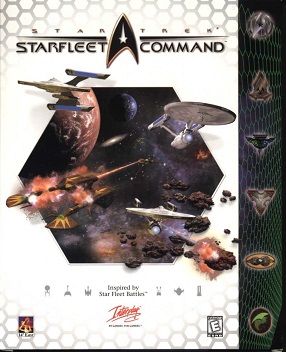
Star Trek: Starfleet Command is a computer game based on the table-top wargame Star Fleet Battles. It was developed by 14° East and Quicksilver Software and published by Interplay Entertainment. It was released in 1999 for Microsoft Windows. It simulates starship operations, ship-to-ship combat, and fleet warfare in the Star Trek universe. An expanded version was released in 2000 titled Star Trek: Starfleet Command - Gold Edition. It includes the latest patch and all the missions that were downloadable from the official website.

Presto Studios was a computer game development company of the 1990s. The company is notable for its award-winning series The Journeyman Project as well as Myst III: Exile, the 2001 sequel to Cyan's Myst series.

Star Trek: Away Team is an isometric real-time tactics video game developed by Reflexive Entertainment and published by Activision. The game was initially released in March 2001 for personal computers using Microsoft Windows in North America. The game is set in the Star Trek universe, after the end of the Dominion War seen in the television series Star Trek: Deep Space Nine. It features a range of new characters, set on board the USS Incursion with voice appearances by Brent Spiner and Michael Dorn as Lieutenant Commander Data and Ambassador Worf, respectively. The game received mixed reviews, with criticism directed at the graphics, elements of the gameplay including the lack of any artificial intelligence, and the limited length of the game.
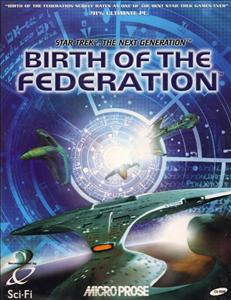
Star Trek: Birth of the Federation is a 4X turn-based strategy video game developed by MicroProse and published by Hasbro Interactive. The game was initially released in 1999 for Windows personal computers.

Star Trek: Invasion is a video game, released in 2000 for the Sony PlayStation console. The game was developed by Warthog Games for Activision. The game also has some distinction being developed by the same team responsible for the Colony Wars series.

Hidden & Dangerous is a 1999 tactical shooter video game developed by Illusion Softworks and published by Take-Two Interactive and TalonSoft for Windows, Dreamcast and PlayStation. The PlayStation port of the game was developed by Tarantula Studios. It is regarded as a pioneering tactical shooter. A sequel, Hidden & Dangerous 2, was released in 2003.

John Saul's Blackstone Chronicles: An Adventure in Terror is a 1998 computer adventure game developed by Legend Entertainment and published by Red Orb Entertainment, a Mindscape subsidiary.
Toys for Bob, Inc. is an American video game developer based in Novato, California. It was founded in 1989 by Paul Reiche III and Fred Ford and is best known for creating Star Control and the Skylanders franchise, as well as for working on the Crash Bandicoot and Spyro franchises.
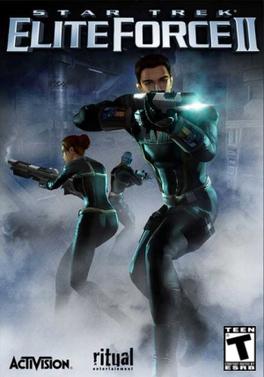
Star Trek: Elite Force II is a first-person shooter video game developed by Ritual Entertainment and published by Activision. It was released on June 20, 2003 for Microsoft Windows and later for Mac OS X. Elite Force II is a sequel to 2000's Star Trek: Voyager – Elite Force. Whereas the original game was powered by the first version of id Software's id Tech 3 engine, Elite Force II is based on a heavily modified version of the Quake III: Team Arena engine with Ritual's ÜberTools GDK, allowing for expansive outdoor environments and higher quality facial animations.

Interstate '82 is a vehicular combat video game developed and published by Activision for Microsoft Windows in 1999.

Star Trek: The Next Generation – Klingon Honor Guard is a first-person shooter set in the universe of Star Trek during the time of The Next Generation. The game was developed by MicroProse in 1998, using the Unreal game engine. The critical response to the title was generally positive with praise for the graphics, but mixed opinions of the level design.

South Park is a first-person shooter video game based on the American animated sitcom of the same name. The game was developed by Iguana Entertainment, using a modified version of the engine used in the Acclaim Entertainment-published Turok 2: Seeds of Evil; both games shared the same publisher and were released for the Nintendo 64 in 1998 in North America, and for Microsoft Windows in 1999. South Park was released in Europe and ported to the PlayStation in the latter year to coincide with the film South Park: Bigger, Longer & Uncut.

Star Trek: Starfleet Command III is a Star Trek video game published in 2002. It was the fourth entry in the Starfleet Command series, and one of the last Star Trek games to be released by Activision. The game involves the a story-driven series of missions for three factions, that is conducted by controlling starships that are developed with RPG elements. The game was released for Windows operating system, and received generally positive reviews.
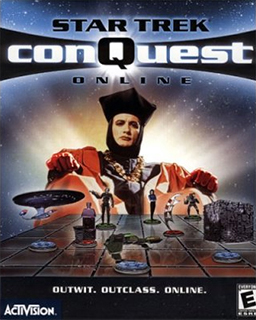
Star Trek: ConQuest Online was an online digital collectible card game set in the Star Trek universe released in June 2000 for the Microsoft Windows by Activision.

Star Trek: Voyager – Elite Force is a first-person shooter video game developed by Raven Software and published by Activision. The game was originally released on September 15, 2000 for Windows and Mac OS. A port for Mac OS developed by Westlake Interactive and published by Aspyr Media was released on November 20, 2002. Elite Force was ported to the PlayStation 2 by Pipe Dream Interactive and published by Majesco Entertainment on December 11, 2001.

Dark Side of the Moon is a 1998 graphic adventure game developed and published by SouthPeak Interactive.


















